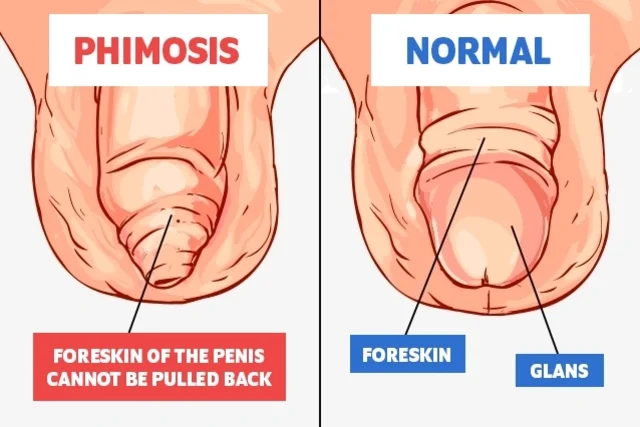
Phimosis is a condition that affects the male genitalia, specifically the foreskin. It is characterized by the inability to fully retract the foreskin over the head of the penis. While it is a relatively common issue, it can cause discomfort, pain, and increase the risk of infections. In this article, we will explore the causes, symptoms, treatment options, and preventive measures for phimosis.
Keywords: Phimosis, Tight foreskin, Foreskin retraction, Paraphimosis, Circumcision
Phimosis occurs when the opening of the foreskin is too narrow, making it difficult or impossible to retract over the head of the penis. This condition can be present from birth (physiological phimosis) or develop later in life due to various factors (pathological phimosis). It is essential to differentiate between physiological and pathological phimosis to determine appropriate treatment options.
(A) Physiological Phimosis: In infants and young boys, the foreskin may not fully retract due to a natural adhesion between the inner surface of the foreskin and the glans penis. This is considered a normal developmental process and usually resolves on its own with time.
(B) Pathological Phimosis: Pathological phimosis can be caused by repeated infections, inflammation, scarring, or conditions like balanitis, lichen Sclerosus, or BXO (Balanitis Xerotica Obliterans). Poor hygiene or forceful retraction attempts can also contribute to the development of pathological phimosis.
The main symptom of phimosis is the inability to retract the foreskin over the glans. Additional symptoms may include discomfort, pain, redness, swelling, and difficulty urinating. In some cases, phimosis can lead to Paraphimosis, a condition where the retracted foreskin becomes trapped behind the glans, causing swelling and potential medical emergencies.
(A) Conservative Measures: For physiological phimosis in infants and young boys, no treatment is usually necessary as it tends to resolve naturally over time. For pathological phimosis, gentle stretching exercises and the application of topical corticosteroid creams can be effective in gradually loosening the foreskin.
(B ) Surgical Intervention: In severe cases or when conservative measures are ineffective, circumcision may be recommended. Circumcision involves the surgical removal of the foreskin and is considered a permanent solution for phimosis.
Maintaining good genital hygiene is crucial in preventing phimosis. It is important to clean the penis regularly, gently retracting the foreskin to rinse away any debris or smegma. However, forceful retraction should be avoided, as it can lead to injury or scarring. Educating boys and their parents about proper genital hygiene practices can significantly reduce the risk of developing phimosis.
Phimosis, characterized by the tightness of the foreskin, can cause discomfort and increase the risk of complications. Understanding the causes, symptoms, treatment options, and preventive measures is essential for managing this condition effectively. While physiological phimosis often resolves naturally, pathological phimosis may require conservative measures or surgical intervention. By practicing good genital hygiene and seeking medical advice when necessary, individuals can take proactive steps in maintaining optimal genital health and overall well-being.
